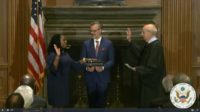The U.S. Environmental Protection Agency has proposed strengthening national air standards for soot pollution and is seeking public comments on a draft standard, it released Jan. 6. Industry and construction groups typically say that more stringent standards would stifle growth, while public health and environmental groups say stronger standards save thousands of lives each year and reduce health care costs.
In the draft, EPA proposes that the National Ambient Air Quality Standards (NAAQS) for fine particle pollution, also called PM2.5, be tightened from the current annual levels of 12 micrograms per cu m to a level between 9 and 10 micrograms per cu m. On a Jan. 5 call with reporters, EPA Administrator Michael Regan said the proposed change reflects the latest health data and scientific evidence. However, in seeking comments, EPA said it will consider all levels between 8 and 11 micrograms per cu m.
The proposal is an update to the 2012 national standard for soot developed during the Obama administration.
Industry groups say the more stringent standard would challenge firms that already have spent millions implementing emission controls to comply with current particulate matter and other air emissions requirements. “The proposed tightening of particulate matter NAAQS will likely result in particulate matter emissions standards being technically and economically infeasible for the industry to meet,” said Mike Ireland, president and CEO of the Portland Cement Association, in a statement.
American Petroleum Institute vice president of downstream policy, Will Hupman, said the current standards are “effective and will continue to build on significant improvements in air quality while protecting public health” He added that the more stringent standards would likely “place new regulatory and cost burdens on state and local governments, businesses, and the public.”
The draft rule “misses the mark,” League of Conservation Voters senior director of government affairs and former EPA health scientist Matthew Davis said in a statement. His group, along with several other environmental advocates, would prefer to see an annual standard of 8 micrograms per cu m, with a 24-hour standard of 25 micrograms per cu m.
NAAQS are a primary health standard that require states to develop plans demonstrating how they will keep annual air pollution levels within specified limits. Once EPA approves a state implementation plan, it is federally enforceable, according to the agency.
Groups including the National Medical Association say NAAQS protect public health, particularly in areas—often low-income communities and communities with disproportionately high percentages of people of color—where industrial and other high-emission facilities are clustered. The air standards typically are achieved by controlling pollution from emission sources, such as smokestacks, power and industrial facilities and construction sites.
States that fail to develop plans can face restrictions in development, including energy and transportation projects. Funding for highway projects in nonattainment areas can be withheld. According to an EPA spokeswoman, these highway sanctions generally don’t apply to areas that fail to meet the NAAQS on time, but instead if a state fails to submit a plan, or one is not approved by EPA.
Currently, there is one county in Pennsylvania and four in California considered to be in nonattainment with the 2012 NAAQS standard for soot. EPA says it has several regulations, including a heavy-vehicle rule proposed in December, in various stages of development that will help reduce fine particulate matter pollution.
EPA will accept public comment for 60 days after the proposal is published in the Federal Register, and says it hopes to finalize the regulation as early as August.




Post a comment to this article
Report Abusive Comment